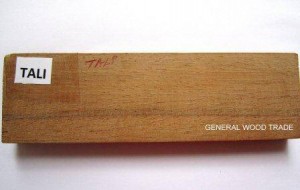Common trade names: Tali
Genus: Erythophleum suaveolens
Janka Hardness (pounds-force): 2920
Description: Tali has a rich, warm hue across the red and brown color spectrum. It’s very hard, grain typically tight, but may be irregular. Tali is a favorite of tropical hardwood enthusiasts virtually everywhere cricket is played. I’ve been watching lots of cricket lately. I’m hoping for a trickle-down effect relating to increased Tali demand. This is, after all, America.
Location: Tropical Africa, specifically Cameroon, Congo, Equatorial Guinea, Gabon, Gambia, Ghana, Guinea Bissau, Ivory Coast, Kenya, Mozambique, Nigeria, Senegal, Sierra Leone, Tanzania, Uganda, Zaire, Zambia.
Common Aliases: Fillaea suaveolens, A-kon, Buirame, Etsa, Tsa, and a host of many others in several languages.
Performance: It’s quite stable, and for a tropical hardwood, it glues well. Painting and staining are a little more relatively difficult with Tali than with some other tropical hardwoods. Painting isn’t something one should be doing with Tali in the first place. Can be sawn, planed, or turned with similar ease to its American tropical counterparts.
Acclimation: Please remember, Tali came from a continent across the ocean, and the tree it became likely grew up in a little different climate than the one in which you live.
If the Ukranians come after me for using this picture, I suppose it will lead to an interesting story, but they aren’t getting any money out of me right this moment.
Common Uses: Tali is much more common as an outdoor solution in Europe than America due to the proximity to the source of the end user. We are still able to bring you this wonderful African beauty at an affordable price. Much like any other tropical hardwoods, it thrives in outdoor applications, as is highly insect repellent. It is also among the least likely of woods to suffer a bout with mold or mildew.
From: Thewoodexplorer.com, Johnny W. Morlan, omoghardwood.com, apptimber.com
Common Name(s): Tali
Scientific Name: Erythrophleum ivorense or Erythrophleum suaveolens
Distribution: Tropical Africa
Tree Size: 100 ft (30 m) tall, 2-3 ft (.6-1.0 m) trunk diameter
Average Dried Weight: 61-67 lbs/ft3
Basic Specific Gravity: .78
Hardness: 2,920lbf (12,989 N)
Rupture Strength: 177 Mpa
Elastic Strength: 15,700 Mpa
Crushing Strength: 78 Mpa
Shrinkage: Radial: 4%, Tangential: 7%, Volumetric: 12%, T/R Ratio: 1.75

